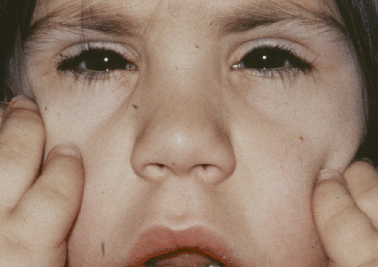Weill-Marchesani syndrome
 From Wikidoc - Reading time: 3 min
From Wikidoc - Reading time: 3 min
Editor-In-Chief: C. Michael Gibson, M.S., M.D. [1] Associate Editor(s)-in-Chief: Jyostna Chouturi, M.B.B.S [2]
| Weill–Marchesani syndrome | |
| Classification and external resources | |

| |
|---|---|
| A six-year-old female with Weill-Marchesani syndrome, which has caused a dislocated lens. |

Overview[edit | edit source]
Weill-Marchesani syndrome (also known as Spherophakia-brachymorphia syndrome, congenital mesodermal dystrophy, and GEMSS syndrome) is a rare, genetic disorder characterized by short stature; an unusually short, broad head (brachycephaly) and other facial abnormalities; hand defects, including unusually short fingers (brachydactyly); and distinctive eye (ocular) abnormalities. These typically include unusually small, round lenses of the eyes (spherophakia) that may be prone to dislocating ectopia lentis as well as other ocular defects. Due to such abnormalities, affected individuals may have varying degrees of visual impairment, ranging from nearsightedness myopia to blindness. Researchers suggest that Weill-Marchesani syndrome may have autosomal recessive or autosomal dominant inheritance[3].
Diagnosis[edit | edit source]
Diagnosis is made when several characteristic clinical signs are observed. There is no single test to confirm the presence of Weill-Marchesani syndrome. Exploring family history or examining other family members may prove helpful in confirming this diagnosis.
Treatment and Prognosis[edit | edit source]
Eye surgery has been documented to help those with ocular diseases, such as some forms of glaucoma.[1]
However, long term medical management of glaucoma has not proven to be successful for patients with Weill-Marchesani syndrome. Physical therapy and orthopedic treatments are generally prescribed for problems stemming from mobility from this connective tissue disorder. However, this disorder has no cure, and generally, treatments are given to improve quality of life. [2]
See also[edit | edit source]
References[edit | edit source]
- ↑ Harasymowycz, P; Wilson, R (2005), "Surgical treatment of advanced chronic angle closure glaucoma in Weill-Marchesani syndrome", J Pediatr Ophthalmol Strabismus, 41 (5): 295–9, 15478742.
- ↑ Anderson, Charles (2002). NORD Guide to Rare Disorders. USA: Lippincott Williams & Wilkins. pp. 266–267. ISBN 0781730635. Unknown parameter
|coauthors=ignored (help)
 KSF
KSF